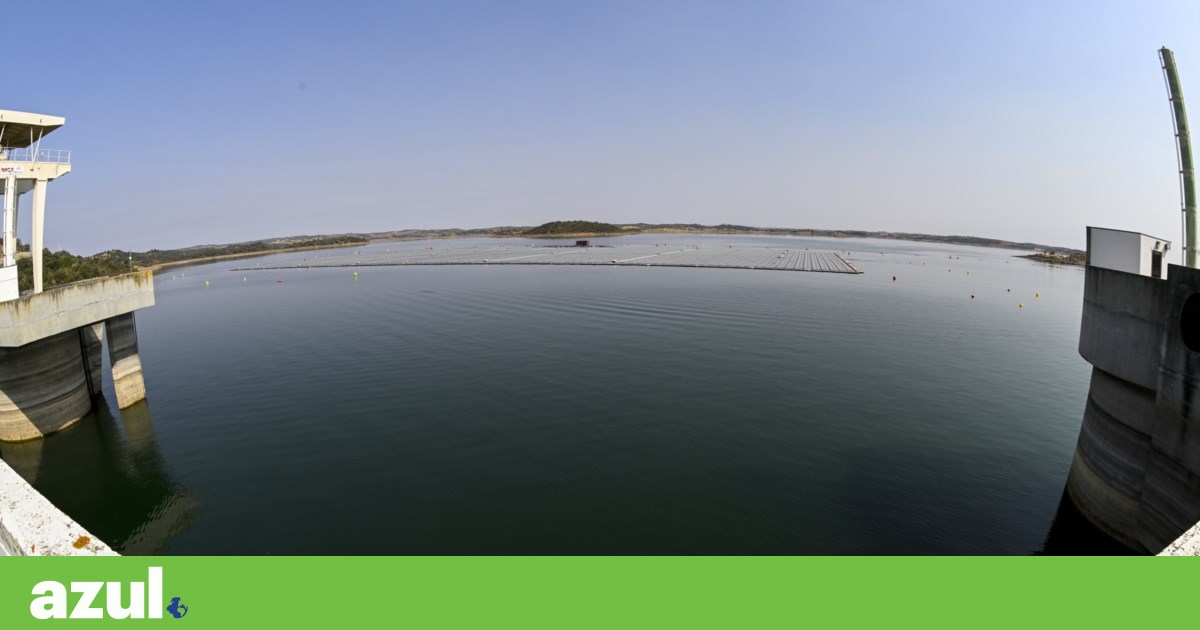The Alqueva reservoir is not only irrigated. The large water mirror formed by one of the largest artificial reservoirs in Europe, in addition to the entertainment it provides through sport fishing, boat trips, observing the night sky and bathing areas that surround the enormous liquid surface, enhances its energy production.
The combination of water, air and sun will turn Alqueva, by 2025, into a huge battery of hybrid energy providing water to about 200,000 hectares of irrigated land and about 100,000 homes.
To the hydroelectric power produced by the two hydroelectric power plants (total installed capacity 520 megawatts (MW), EDP added, in July 2022, A floating photovoltaic station with about 12,000 photovoltaic panels With an installed capacity of 5 megawatts. The company told PÚBLICO that this equipment, which is the largest in Europe to be installed in tanks, has recorded “stable operation since July last year, while maintaining an annual production estimate of 7.5 GWh (GWh).
“It does not stop there,” stressed Miguel Stilwell d’Andrade, CEO of EDP, in his speech during the solar plant’s inauguration ceremony. “We will expand to about 70 megawatts.” This means an almost 15-fold increase and until 2025 the area occupied by the already installed photovoltaic plant. Miguel Stilwell added that wind projects (turbines will be located a few kilometers from Alqueva) and solar projects are scheduled to produce about “150 megawatts of energy”.
The photovoltaic plant opened in July 2022 in Alqueva already as a sanctuary for fish that seek shade to protect themselves from predators, while feeding on the algae growing on the buoys that support the solar panels.
New factory increases floating platform
PÚBLICO EDP asked if this second floating terminal would be installed next to the first. The company explained that it is “coordinating” the definition of the project with the most diverse parties involved in the licensing process, to clarify its composition with the remaining activities and uses of the reservoir.
One of the factors that makes photovoltaic power plants profitable is the short distance from the connection point to the public grid to reduce energy losses as much as possible. Thus, it is envisaged that the new floating power plant “will be installed close to the one already installed,” admitted PÚBLICO José Pedro Salema, President of Alqueva Development and Infrastructure Company, EDIA.
The technical specifications accompanying the installation of floating power plants indicate that only 3% of the Kuiva reservoir area (25,000 hectares, when fully covered by water) will be occupied in the future by solar panels, leaving 97% of the surface devoid of other activities.
However, the developments that can be observed in the level of the reservoir must be taken into account, as there are banks with steep slopes adjacent to the dam wall and subject to fluctuations in the water level of more than 20 meters and What In the deepest area, they reach 70 meters.
Alqueva’s solar power platform, the largest in Europe installed on a tank, will start operating in July 2022
The region’s first solar and wind hybrid park
This is “the region’s first solar-wind hybrid farm” from Alentejo, whose EDP will be installed next to the Alqueva hydroelectric plant, boosting annual energy production by up to 300 gigawatt-hours, the company notes in its Annual Integrated Report (RAI). relating to the year 2022.
With this increase in Renewable energy About 92,000 homes will be provided. The excess energy generated on days with more sunshine can still be used to pump water back into the reservoir, and then used to generate electricity on cloudy days or at night.
And so I became Alqueva classify for a living laboratory, by allowing testing of integration between renewable energy production technologies, as well as long-term hydro energy storage technologies that use a pumping system and solar energy, which are short-lived and require a battery for energy storage,” explained RAI.
At the same time, and in order to “free itself” from energy dependence on EDP, an entity that in 2007 acquired the subconcession with direct agreement and until 2042 to operate the hydroelectric power plants in Alqueva and Pedrógão, EDIA has already advanced the installation of “20 photovoltaic power plants revealed to PÚBLICO Pedro Salema.
The official makes a strong argument: “In our country, each hectare of agricultural area consumes 1,750 kilowatt-hours (kWh) of energy. This amount of energy can be produced by a 1-kilowatt (kWh) photovoltaic system, which is Equivalent to installing 2.5 photovoltaic panels.
SOPA Pictures
Increased station consumption
Most of the 47 pumping stations of the Alqueva Multipurpose Project (EFMA), which direct water to supply 22 irrigation blocks through 382 km of the primary network and 1,620 km of pipelines in the secondary network, have very high nominal powers.
The most illustrative example is the Álamos pumping station, which supplies water to the Alqueva subsystem, which has a nominal capacity of 42 MW. The largest in Europe . The projected fee for energy consumption in 2022 will have reached 38 million euros, a value much higher than that recorded in the same period, practically twice what was paid to the EDP. The cost of energy consumed by the Álamos power plant alone is €2.2 million per month, which is unaffordable to run a hydroponics project.
“The path must be different,” stresses Pedro Salema, explaining that IDEA launched at the end of May an international public tender for the first five floating photovoltaic plants to be installed in the reservoirs of Ferreira do Alentejo, Almedas, Bia, Bindrao and Monte Novo, with a total capacity of 4.5 megawatts (peak megawatts), with an estimated annual production of 7 gigawatt-hours, which means an investment of about 4 million 320 thousand euros.
“Alqueva has thus become a kind of living laboratory, by allowing the testing of integration between renewable energy production technologies, as well as long-term hydro energy storage technologies that use a pumping system and solar energy that does not last long and needs a battery to store energy”
Floating and terrestrial plants
The stations to be installed will mainly feed the nearby pumping stations and reservoirs. Of the 20 plants that EDIA has planned to install, some will occupy floating platforms, others will be built on land next to the pumping stations, “and there will be no conflict with anything,” the EDIA president assured.
“Funding is available for all centers Pedro Salima stressed, adding that about 60 million euros will be invested to ensure cheap energy for irrigated lands and there will be a period of the year, between November and February, when it will be put into the public supply network. During this period the pumping station pumps will stop. It’s not the time to water.
There is another advantage of installing floating photovoltaic plants: the power output is greater, as the cooling effect of the water on the panels increases their efficiency in converting radiation into electricity.
In addition, reducing the incidence of light on the liquid surface covered by the solar panels limits algae growth and water evaporation, thus reducing the cost of cleaning the filters that are used to purify water for irrigation.
The Alqueva photovoltaic plant with more than 11,000 panels required the installation of 25,000 buoys occupying four hectares in the Alqueva Reservoir. It is manufactured on the basis of a new composite that includes cork and recycled plastic. The EDP states that the floating solar project can achieve a reduction of at least 30% in carbon dioxide emissions and provide “greater resistance to temperature extremes, ensure chemical compatibility and have anti-vibration properties and low thermal conductivity.”
The photovoltaic plant opened in July 2022 in Alqueva already as a sanctuary for fish that seek shade to protect themselves from predators, while feeding on the algae growing on the buoys that support the solar panels.



